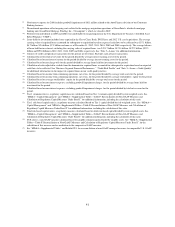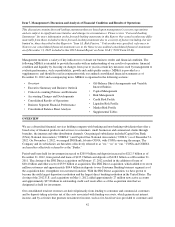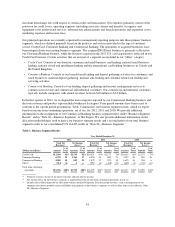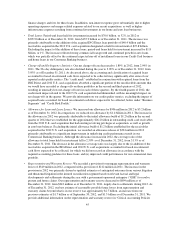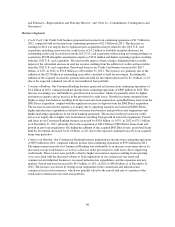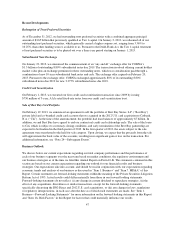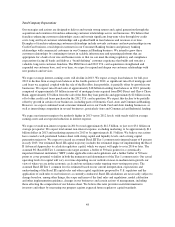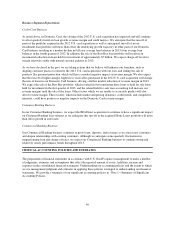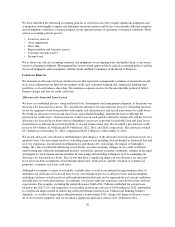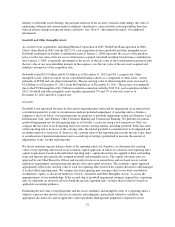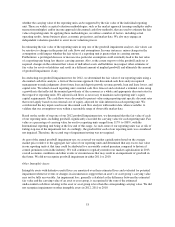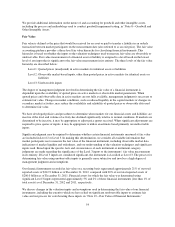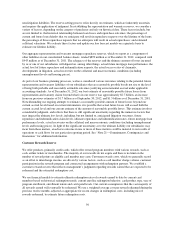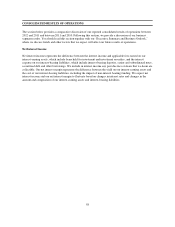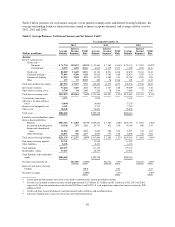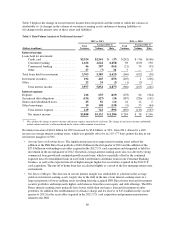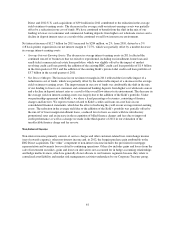Capital One 2012 Annual Report Download - page 70
Download and view the complete annual report
Please find page 70 of the 2012 Capital One annual report below. You can navigate through the pages in the report by either clicking on the pages listed below, or by using the keyword search tool below to find specific information within the annual report.We provide additional information on the methodologies and key assumptions used in determining our allowance
for loan and lease losses for each of our loan portfolio segments in “Note 1—Summary of Significant Accounting
Policies.” We provide information on the components of our allowance, disaggregated by impairment
methodology, and changes in our allowance in “Note 6—Allowance for Loan and Lease Losses.”
Finance Charge and Fee Reserve
We recognize finance charges and fees on credit card loans as revenue when the amounts are billed to the
customer and include these amounts in the loan balance, net of the estimated uncollectible amount of billed
finance charges and fees. We continue to accrue finance charges and fees on credit card loans until the account is
charged-off; however, when we do not expect full payment of billed finance charges and fees, we reduce the
balance of our credit card loan receivables by the amount of finance charges and fees billed but not expected to
be collected and exclude this amount from revenue. Total net revenue was reduced by $937 million, $371 million
and $950 million in 2012, 2011, 2010, respectively, for the estimated uncollectible amount of billed finance
charges and fees. The finance charge and fee reserve totaled $307 million as of December 31, 2012, compared
with $74 million as of December 31, 2011.
We review and assess the adequacy of the uncollectible finance charge and fee reserve on a quarterly basis. Our
methodology for estimating the uncollectible portion of billed finance charges and fees is primarily based on the
use of a roll-rate methodology and consistent with the methodology we use to estimate the allowance for incurred
principal losses on our credit card loan receivables. Accordingly, the estimation process is subject to similar risks
and uncertainties, including a reliance on historical loss and trend information that may not be representative of
current conditions and indicative of future performance. We refine our estimation process and key assumptions
used in determining our loss reserves as additional information becomes available. Changes in key assumptions
may have a material impact on the amount of billed finance charges and fees we estimate as uncollectible in each
period. For example, in the third quarter of 2011, we revised the manner in which we estimate expected
recoveries of finance charge and fee amounts previously considered to be uncollectible. Our revised recovery
assumptions better reflected the post-recession pattern of relatively low delinquency roll-rates combined with
increased recoveries of finance charges and fees previously considered uncollectible. This change in assumptions
resulted in a reduction in our uncollectible finance charge and fee reserves of approximately $83 million and a
corresponding increase in revenues. We also applied these revised assumptions to the estimated recovery of
principal charge-offs in determining our allowance for loan and lease losses.
Asset Impairment
In addition to our loan portfolio, we review other assets for impairment on a regular basis in accordance with
applicable impairment accounting guidance. This process requires significant management judgment and
involves various estimates and assumptions. Our investment securities and goodwill and intangible assets
represent a significant portion of our other assets. Accordingly, below we describe our process for assessing
impairment of these assets and the key estimates and assumptions involved in this process.
Investment Securities
We regularly review investment securities for other-than-temporary impairment using both quantitative and
qualitative criteria. If we intend to sell a security in an unrealized loss position or it is more likely than not that
we will be required to sell the security prior to recovery of its amortized cost basis, the entire difference between
the amortized cost basis of the security and its fair value is recognized in earnings. If we do not intend to sell the
security and it is not more likely than not that we will be required to sell the security before recovery of our
amortized cost, we evaluate other qualitative criteria to determine whether a credit loss exists. Our evaluation
requires significant management judgment and a consideration of many factors, including, but not limited to, the
extent and duration of the impairment; the health of and specific prospects for the issuer, including whether the
issuer has failed to make scheduled interest or principal payments; recent events specific to the issuer and/or
51


